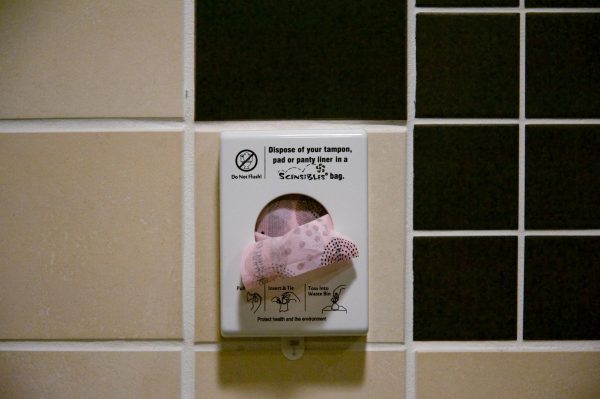Big Pharma Lawsuits Won’t Sufficiently Address Opioid Crisis
In a landmark case that concluded on Aug. 26, Judge Thad Balkman of Oklahoma ordered biotech company Johnson & Johnson to pay the state $572 million for their hand in the prescription opioid epidemic that continues to ravage the country. When I first learned of the case, I didn’t understand how the company known for making baby powders and soaps had a hand in perpetuating the opioid epidemic. Upon further research, I found that Johnson & Johnson actually has a hand in almost every major aspect of pharmaceuticals and first aid supplies. The company owns brands such as Band-Aid, Tylenol, Neutrogena, Acuvue contacts, Clean and Clear, and — of course — Johnson’s baby products.
However, consumer products only scratch the surface of what Johnson & Johnson actually sells. Among their other products are many well-known medications that treat a range of conditions, including autoimmune diseases, HIV, hepatitis, ADHD, depression, tuberculosis, and cancer. They also sell medical and surgical devices, supplies for diabetes care, joint replacements, arrhythmia, and bariatric surgeries.
With such a large array of products for sale, prescription opioids made up a rather small percentage of Johnson & Johnson’s overall sales. Despite this, the state of Oklahoma argued that Johnson & Johnson played a major role in the perpetuation of the opioid epidemic in Oklahoma, in two primary ways.
First, the state alleged that the company was responsible for the development of a poppy strain that later became a major ingredient in oxycodone and hydrocodone, both of which are responsible for a large percentage of opioid overdoses nationwide. The second core part of the argument was that Johnson & Johnson made around 150,000 visits to medical offices in Oklahoma to promote their opioid products to physicians, in the hopes that doctors would choose to prescribe their opioid products over other painkillers. Thus, Judge Balkman concluded that Johnson & Johnson both aided in the development of highly addictive drugs and deceitfully marketed prescription opioids to both doctors and the public.
Although media outlets have widely covered the Johnson & Johnson suit, two other companies — Purdue Pharma and Teva Pharmaceutical — were also recently sued in Oklahoma; however, both settled out of court. Altogether, the three companies will pay almost $930 million for their role in the opioid epidemic.
Oklahoma’s success in the Johnson & Johnson suit has been widely celebrated throughout the country. Since the news about Johnson & Johnson broke, numerous other states have geared up to file similar suits against companies for the roles they have played in the opioid crisis. Many people are celebrating the fact that opioid companies are finally being held legally responsible for the deaths of millions. However, I am a bit skeptical.
I do believe that drug companies should be held responsible for the devastation they have caused. However, simply suing these companies is not a long-term solution.
Johnson & Johnson’s annual revenue in 2018 was $81.53 billion. So, while $572 million is undeniably a huge amount of money, it does not even make a dent in Johnson & Johnson’s revenue as a whole. Sure, the lawsuit is bad press for the company; however, it doesn’t impact Johnson & Johnson’s ability to continue to dominate the pharmaceutical field. The punishment is simply not a strong enough incentive for the company to substantially change their practices.
Furthermore, the state of Oklahoma predicted that they would need almost $900 million per year over the next 20 years — a total of more than $17 billion — in order to address the epidemic by increasing the capacity of rehabilitation centers and increasing support for mental health services. Suing three major big pharma companies is still not enough to address the problem; the legal outcomes raised enough money for only one year. Thus, simply suing pharmaceutical companies is not the effective, clean solution to the opioid epidemic that many people across the United States believe it to be. It is entirely unsustainable. While Oklahoma will collect money from these individuals, it does not have a great enough effect on the opioid crisis to dedicate the amount of time, energy, and money that the state would be forced to spend on lawsuits.
Finally, while holding companies responsible for the damage that they have caused is certainly a good thing, it is highly unlikely that it will lead to a decrease in opioid-related deaths. As I have written previously in the Review, attacking dealers and doctors who overprescribe opioid pills has not been an effective method in the fight against opioids, and I believe that attacking corporations that do the same will be similarly ineffective.
In “Opioid Epidemic Cannot Be Fought Through War on Drugs,” I presented numerous statistics highlighting that when state governments implement policies that crack down on prescription opioids, the positive results are outweighed by negative ones (The Oberlin Review, Feb. 16, 2018). In almost every case where prescription opioid policies were enacted, the drop in prescription opioid deaths was met with a dramatic increase in heroin-related deaths. Thus, when prescription opioids are harder to access, addicts simply move on to other, more accessible opioids. A similar pattern happened with heroin: Heroin crackdowns in 2017 and 2018 brought drops in heroin-related deaths, but major spikes in fentanyl-related deaths.
I still believe companies should be held responsible for their roles in the opioid epidemic. However, we cannot think of these lawsuits as solutions. They are a form of retribution for those who have been affected by the opioid crisis, but they will not stop other families from being impacted in the future.
There are plenty of steps we could be taking now to decrease the rate of opioid-related deaths across the country. Such solutions include opening safe injection sites, making Narcan readily available to addicts and emergency responders, investing in rehabilitation centers, lab research that specializes in opioid addiction, and more.
How will the money from these lawsuits be used? Will the victims of the opioid epidemic directly reap the benefits of the lawsuit? If so, how? And what policies will the state implement to keep people safe in the future? These are the questions we must ask the state to hold it accountable.




